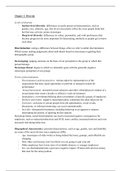Chapter 2: Diversity
Levels of diversity
- Surface-level diversity: differences in easily perceived characteristics, such as
gender, race, ethnicity, age, that do not necessarily reflect the ways people think/feel
but that may activate certain stereotypes
- Deep-level diversity: differences in values, personality, and work preferences that
become progressively more important for determining similarity as people get to know
each other
Discrimination: noting a difference between things, often we refer to unfair discrimination.
Which means making judgements about individuals based on stereotypes regarding their
demographic group.
Stereotyping: judging someone on the basis of our perception to the group to which that
person belongs.
Stereotype threat: degree to which we internally agree with the generally negative
stereotypes perception of our groups.
Forms of discrimination
- Discriminatory policies/practices: Actions taken by representatives of the
organization that deny equal opportunity to perform or unequal rewards for
performance
- Sexual harassment: unwanted sexual advances and other verbal/physical conduct of a
sexual nature that create a hostile or offensive work environment
- Intimidation: overt threats/bullying direct at members of specific groups of employees
- Mockery and insults: negative stereotypes/jokes; sometimes the jokes taken too far
- Exclusion: exclusion of certain people from job opportunities, social events,
discussions, or informal mentoring; can occur unintentionally
- Incivility: disrespectful treatment, including behaving in an aggressive manner,
interrupting the person, of ignoring his/her opinion.
Stereotype threat, actual discrimination can lead to increased negative consequences for
employers, such as reduced productivity and OCB, more conflict, increased turnover and even
increased risk-taking behaviour.
Biographical characteristics: personal characteristics, such as age, gender, race and disability
are some of the most obvious ways employees differ.
- Age: stereotypes of older works as being behind the times, grumpy, and inflexible are
changing.
- How older you become, how less likely you are going to quit your job
- Older employees have lower rates of avoidable absence vs younger employees
- Sex: sex discrimination has a pervasive negative impact. Women still earn less money
that men for the same position.
, - Race an ethnicity:
Positive diversity climate: an environment of inclusiveness and an acceptance of
diversity.
- Disabilities:
Other differentiating characteristics
- Tenure: time spent in a job, organization, or field
- Religion
- Sexual orientation and gender identity
- Cultural identity
Ability: individual’s capacity to perform the various tasks in job
Intellectual abilities: abilities needed to perform mental activities; thinking, reasoning, and
problem solving. Intelligence dimensions are positively correlated.
General mental ability (GMA): overall factor of intelligence, as suggested by the positive
correlations among specific intellectual ability dimensions.
Dimensions of intellectual ability Description
Number aptitude Ability to do speedy and accurate arithmetic
(simple calculations)
Verbal comprehension Ability to understand what is read or heard
and the relationship of words to each other
Perceptual speed Ability to identify visual similarities and
differences quickly and accurately
Inductive reasoning Ability to identify a logical sequence in a
problem and then solve the problem
Deductive reasoning Ability to use logic and assess the
implication of an argument
Spatial visualization Ability to imagine how an object would
look if its position in space were changed
Memory Ability to retain and recall past experience
Physical abilities: capacity to do tasks that demand stamina, dexterity (skill and grace in
movement), strength, and similar characteristics.
Nine basic physical abilities
Strength factors
Dynamic strength Ability to exert muscular force repeatedly or
continuously over time
Trunk strength Ability to exert muscular strength using the
trunk (abs) muscles
Static strength Ability to exert force against external object





